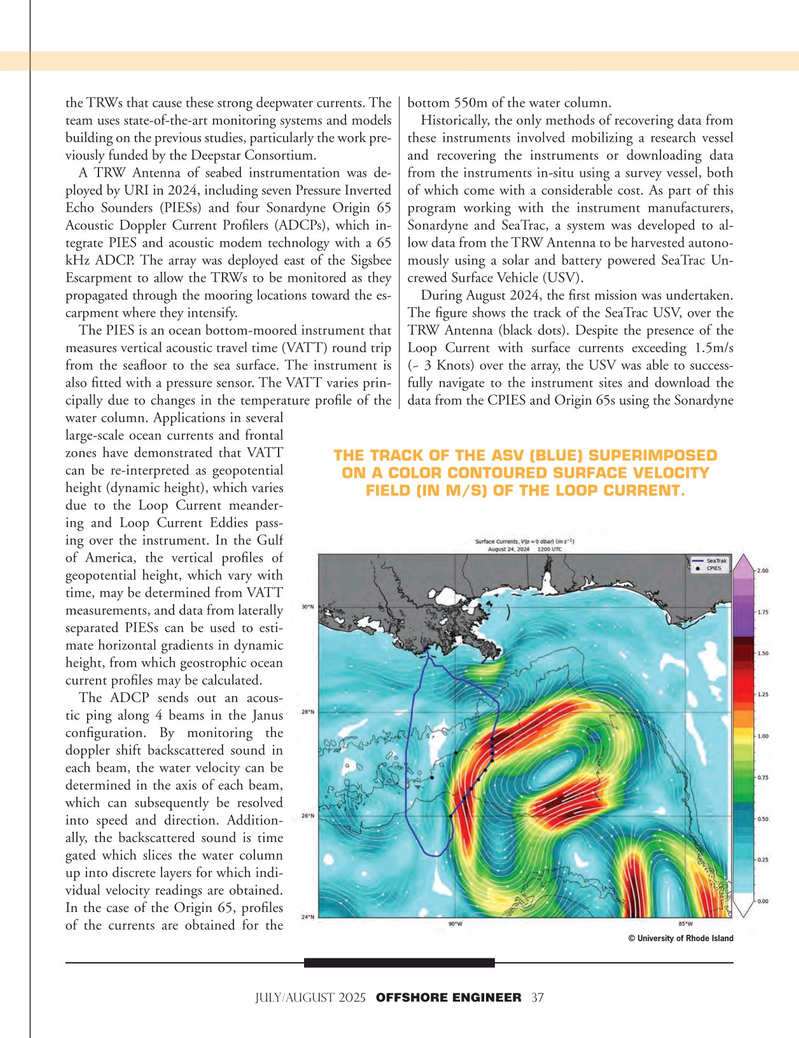
Page 37: of Offshore Engineer Magazine (Jul/Aug 2025)
Read this page in Pdf, Flash or Html5 edition of Jul/Aug 2025 Offshore Engineer Magazine
the TRWs that cause these strong deepwater currents. The bottom 550m of the water column.
team uses state-of-the-art monitoring systems and models Historically, the only methods of recovering data from building on the previous studies, particularly the work pre- these instruments involved mobilizing a research vessel viously funded by the Deepstar Consortium. and recovering the instruments or downloading data
A TRW Antenna of seabed instrumentation was de- from the instruments in-situ using a survey vessel, both ployed by URI in 2024, including seven Pressure Inverted of which come with a considerable cost. As part of this
Echo Sounders (PIESs) and four Sonardyne Origin 65 program working with the instrument manufacturers,
Acoustic Doppler Current Proflers (ADCPs), which in- Sonardyne and SeaTrac, a system was developed to al- tegrate PIES and acoustic modem technology with a 65 low data from the TRW Antenna to be harvested autono- kHz ADCP. The array was deployed east of the Sigsbee mously using a solar and battery powered SeaTrac Un-
Escarpment to allow the TRWs to be monitored as they crewed Surface Vehicle (USV).
propagated through the mooring locations toward the es- During August 2024, the frst mission was undertaken. carpment where they intensify. The fgure shows the track of the SeaTrac USV, over the
The PIES is an ocean bottom-moored instrument that TRW Antenna (black dots). Despite the presence of the measures vertical acoustic travel time (VATT) round trip Loop Current with surface currents exceeding 1.5m/s from the seafoor to the sea surface. The instrument is (~ 3 Knots) over the array, the USV was able to success- also ftted with a pressure sensor. The VATT varies prin- fully navigate to the instrument sites and download the cipally due to changes in the temperature profle of the data from the CPIES and Origin 65s using the Sonardyne water column. Applications in several large-scale ocean currents and frontal zones have demonstrated that VATT
THE TRACK OF THE ASV (BLUE) SUPERIMPOSED can be re-interpreted as geopotential
ON A COLOR CONTOURED SURFACE VELOCITY height (dynamic height), which varies
FIELD (IN M/S) OF THE LOOP CURRENT.
due to the Loop Current meander- ing and Loop Current Eddies pass- ing over the instrument. In the Gulf of America, the vertical profles of geopotential height, which vary with time, may be determined from VATT measurements, and data from laterally separated PIESs can be used to esti- mate horizontal gradients in dynamic height, from which geostrophic ocean current profles may be calculated.
The ADCP sends out an acous- tic ping along 4 beams in the Janus confguration. By monitoring the doppler shift backscattered sound in each beam, the water velocity can be determined in the axis of each beam, which can subsequently be resolved into speed and direction. Addition- ally, the backscattered sound is time gated which slices the water column up into discrete layers for which indi- vidual velocity readings are obtained.
In the case of the Origin 65, profles of the currents are obtained for the © University of Rhode Island
JULY/AUGUST 2025 OFFSHORE ENGINEER 37

 36
36

 38
38